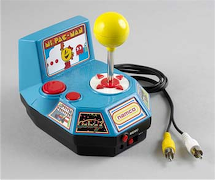 Problem Statement
Problem Statement  Design Design |
 Evaluation Evaluation |
 Solution Solution |
Quibbler
Design |
05 Controls |
We looked at a variety of existing controls and prototyped a variety of controls to explore what are the best possible ways to control a robot. There are currently a wide variety of controllers for video games and a general trend they seem to follow is that they are two-handed, with the left hand having directional controls (such as navigating a character) and right button having more action button controls (such as making selections).


Some controllers had an analog directional pad with continuous control in 360 degrees and some have more discrete controls with four raised points to emphasize the compass directional points (and some had both on the same side). There are also controllers that have a joystick as their primary input.


Rotating Slider
One experimental prototype we had was a slider that could rotate between the axes of the first quadrant. We envisioned that this control would control a single robot arm at the shoulder joint. The depicted control would control the right arm so that rotating the entire control would move sweep the arm between the front of the robot and the right side. The "needle" would also slide in and out which would map to lowering and raising the arm of the robot.
Spherical 6-axes Rotation Input
We prototyped our vision of an integrated input device that would allow the user to control the various movements in 3D. We imagine that this sphere can be rotated along all the 3D axes to provide integrated control of a complex part such as the robot's arm.